At UCLA-NLP, our mission is to develop reliable, fair, accountable, robust natural language understanding and generation technology to benefit everyone. See our recent papers here
ACL is one of the major conferences in the field of natural language processing (NLP). We will participate in the following activities this year.
Tutorial
We will present a tutorial on “Indirectly Supervised Natural Language Processing” in 14:00-17:30 on 7/9
Dear @ACLattendees: Prepare to be blown away at our mind-blowing tutorial "Indirectly Supervised NLP"! Join us at the "Metropolitan Centre" hall on July 9th, sharp at 2pm. Your attendance and comments are priceless. @muhao_chen @BenZhou96 , Qiang Ning, @kaiwei_chang @DanRothNLP pic.twitter.com/vt5D6O79bO
— Wenpeng_Yin (@Wenpeng_Yin) July 7, 2023
Workshop
We will host the 3rd Trustworthy Natual Language Processing Workshop on 7/14.
Accepted Papers
we will present papers on the following topics:
- Trustworthy NLP
- Efficient Shapley Values Estimation by Amortization for Text Classification, Chenghao Yang, Fan Yin, He He, Kai-Wei Chang, Xiaofei Ma, and Bing Xiang, in ACL, 2023. Details
- Resolving Ambiguities in Text-to-Image Generative Models, Ninareh Mehrabi, Palash Goyal, Apurv Verma, Jwala Dhamala, Varun Kumar, Qian Hu, Kai-Wei Chang, Richard Zemel, Aram Galstyan, and Rahul Gupta, in ACL, 2023. Details
- The Tail Wagging the Dog: Dataset Construction Biases of Social Bias Benchmarks, Nikil Roashan Selvam, Sunipa Dev, Daniel Khashabi, Tushar Khot, and Kai-Wei Chang, in ACL (short), 2023. Details
- PLUE: Language Understanding Evaluation Benchmark for Privacy Policies in English, Jianfeng Chi, Wasi Uddin Ahmad, Yuan Tian, and Kai-Wei Chang, in ACL (short), 2023. Details
- Vision-Language and Multimodal Model
- MetaVL: Transferring In-Context Learning Ability From Language Models to Vision-Language Models, Masoud Monajatipoor, Liunian Harold Li, Mozhdeh Rouhsedaghat, Lin Yang, and Kai-Wei Chang, in ACL (short), 2023. Details
- UniFine: A Unified and Fine-grained Approach for Zero-shot Vision-Language Understanding, Rui Sun, Zhecan Wang, Haoxuan You, Noel Codella, Kai-Wei Chang, and Shih-Fu Chang, in ACL-Finding, 2023. Details
- AVATAR: A Parallel Corpus for Java-Python Program Translation, Wasi Ahmad, Md Golam Rahman Tushar, Saikat Chakraborty, and Kai-Wei Chang, in ACL-Finding (short), 2023. Details
- Language and Reasoning
- A Survey of Deep Learning for Mathematical Reasoning, Pan Lu, Liang Qiu, Wenhao Yu, Sean Welleck, and Kai-Wei Chang, in ACL, 2023. Details
- Symbolic Chain-of-Thought Distillation: Small Models Can Also "Think" Step-by-Step, Liunian Harold Li, Jack Hessel, Youngjae Yu, Xiang Ren, Kai-Wei Chang, and Yejin Choi, in ACL, 2023. Details
- Semantic and Syantatic Analysis
- TAGPRIME: A Unified Framework for Relational Structure Extraction, I.-Hung Hsu, Kuan-Hao Huang, Shuning Zhang, Wenxin Cheng, Prem Natarajan, Kai-Wei Chang, and Nanyun Peng, in ACL, 2023. Details
- ParaAMR: A Large-Scale Syntactically Diverse Paraphrase Dataset by AMR Back-Translation, Kuan-Hao Huang, Varun Iyer, I.-Hung Hsu, Anoop Kumar, Kai-Wei Chang, and Aram Galstyan, in ACL, 2023. Details
- GENEVA: Pushing the Limit of Generalizability for Event Argument Extraction with 100+ Event Types, Tanmay Parekh, I.-Hung Hsu, Kuan-Hao Huang, Kai-Wei Chang, and Nanyun Peng, in ACL, 2023. Details
- Enhancing Unsupervised Semantic Parsing with Distributed Contextual Representations, Zixuan Ling, Xiaoqing Zheng, Jianhan Xu, Jinshu Lin, Kai-Wei Chang, Cho-Jui Hsieh, and Xuanjing Huang, in ACL-Finding, 2023. Details
- PIP: Parse-Instructed Prefix for Syntactically Controlled Paraphrase Generation, Yixin Wan, Kuan-Hao Huang, and Kai-Wei Chang, in ACL-Finding (short), 2023. Details
Efficient Shapley Values Estimation by Amortization for Text Classification
Chenghao Yang, Fan Yin, He He, Kai-Wei Chang, Xiaofei Ma, and Bing Xiang, in ACL, 2023.
QA Sessions: Interpretability and Analysis of Models for NLP 2: 7/11 5:45PM Paper link in the virtual conferenceFull Text BibTeX DetailsDetails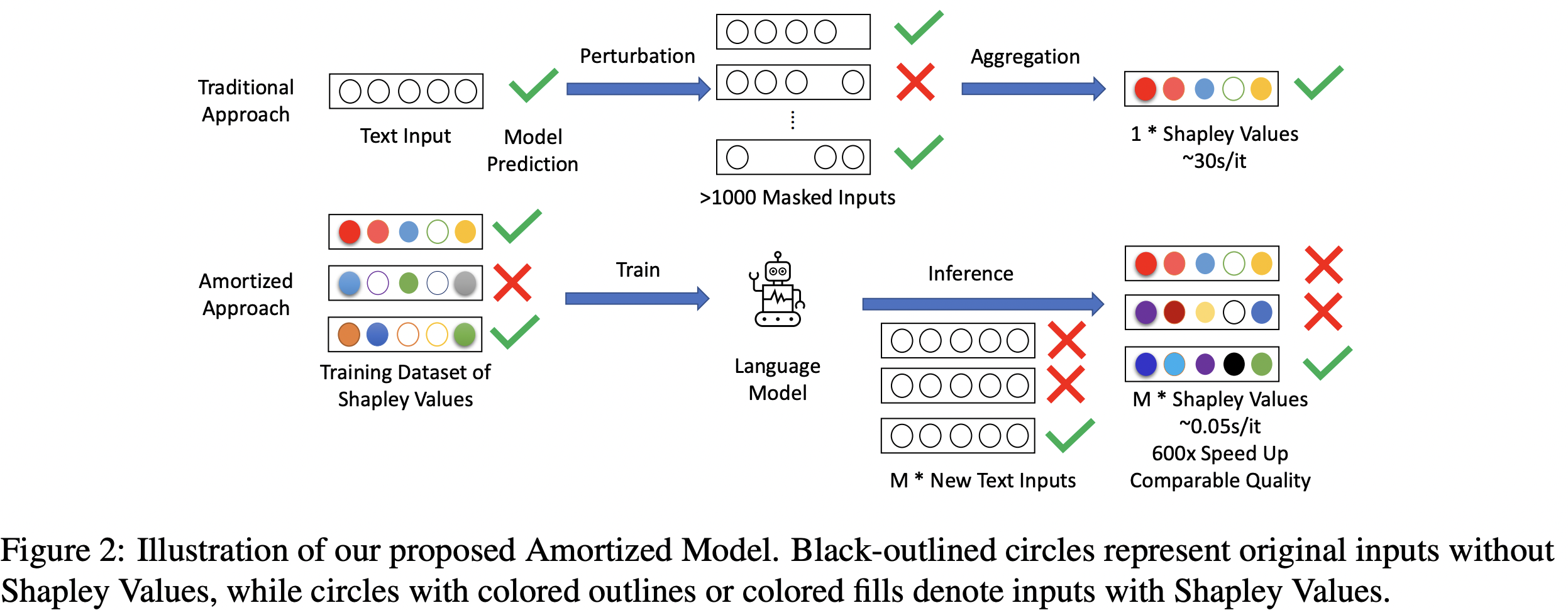
Despite the popularity of Shapley Values in explaining neural text classification models, computing them is prohibitive for large pretrained models due to a large number of model evaluations as it needs to perform multiple model evaluations over various perturbed text inputs. In practice, Shapley Values are often estimated stochastically with a smaller number of model evaluations. However, we find that the estimated Shapley Values are quite sensitive to random seeds – the top-ranked features often have little overlap under two different seeds, especially on examples with the longer input text. As a result, a much larger number of model evaluations is needed to reduce the sensitivity to an acceptable level. To mitigate the trade-off between stability and efficiency, we develop an amortized model that directly predicts Shapley Values of each input feature without additional model evaluation. It is trained on a set of examples with Shapley Values estimated from a large number of model evaluations to ensure stability. Experimental results on two text classification datasets demonstrate that, the proposed amortized model can estimate black-box explanation scores in milliseconds per sample in inference time and is up to 60 times more efficient than traditional methods.
@inproceedings{yang2023efficient, title = {Efficient Shapley Values Estimation by Amortization for Text Classification}, author = {Yang, Chenghao and Yin, Fan and He, He and Chang, Kai-Wei and Ma, Xiaofei and Xiang, Bing}, year = {2023}, presentation_id = {https://underline.io/events/395/sessions/15249/lecture/76179-efficient-shapley-values-estimation-by-amortization-for-text-classification}, booktitle = {ACL} }Related Publications
-
Efficient Shapley Values Estimation by Amortization for Text Classification
Chenghao Yang, Fan Yin, He He, Kai-Wei Chang, Xiaofei Ma, and Bing Xiang, in ACL, 2023.
Full Text Abstract BibTeX DetailsDetailsDespite the popularity of Shapley Values in explaining neural text classification models, computing them is prohibitive for large pretrained models due to a large number of model evaluations as it needs to perform multiple model evaluations over various perturbed text inputs. In practice, Shapley Values are often estimated stochastically with a smaller number of model evaluations. However, we find that the estimated Shapley Values are quite sensitive to random seeds – the top-ranked features often have little overlap under two different seeds, especially on examples with the longer input text. As a result, a much larger number of model evaluations is needed to reduce the sensitivity to an acceptable level. To mitigate the trade-off between stability and efficiency, we develop an amortized model that directly predicts Shapley Values of each input feature without additional model evaluation. It is trained on a set of examples with Shapley Values estimated from a large number of model evaluations to ensure stability. Experimental results on two text classification datasets demonstrate that, the proposed amortized model can estimate black-box explanation scores in milliseconds per sample in inference time and is up to 60 times more efficient than traditional methods.
@inproceedings{yang2023efficient, title = {Efficient Shapley Values Estimation by Amortization for Text Classification}, author = {Yang, Chenghao and Yin, Fan and He, He and Chang, Kai-Wei and Ma, Xiaofei and Xiang, Bing}, year = {2023}, presentation_id = {https://underline.io/events/395/sessions/15249/lecture/76179-efficient-shapley-values-estimation-by-amortization-for-text-classification}, booktitle = {ACL} }
-
Resolving Ambiguities in Text-to-Image Generative Models
Ninareh Mehrabi, Palash Goyal, Apurv Verma, Jwala Dhamala, Varun Kumar, Qian Hu, Kai-Wei Chang, Richard Zemel, Aram Galstyan, and Rahul Gupta, in ACL, 2023.
QA Sessions: POSTER SESSION 4:July 11 11:00 AM - July 11 12:30 AM Paper link in the virtual conferenceFull Text BibTeX DetailsDetails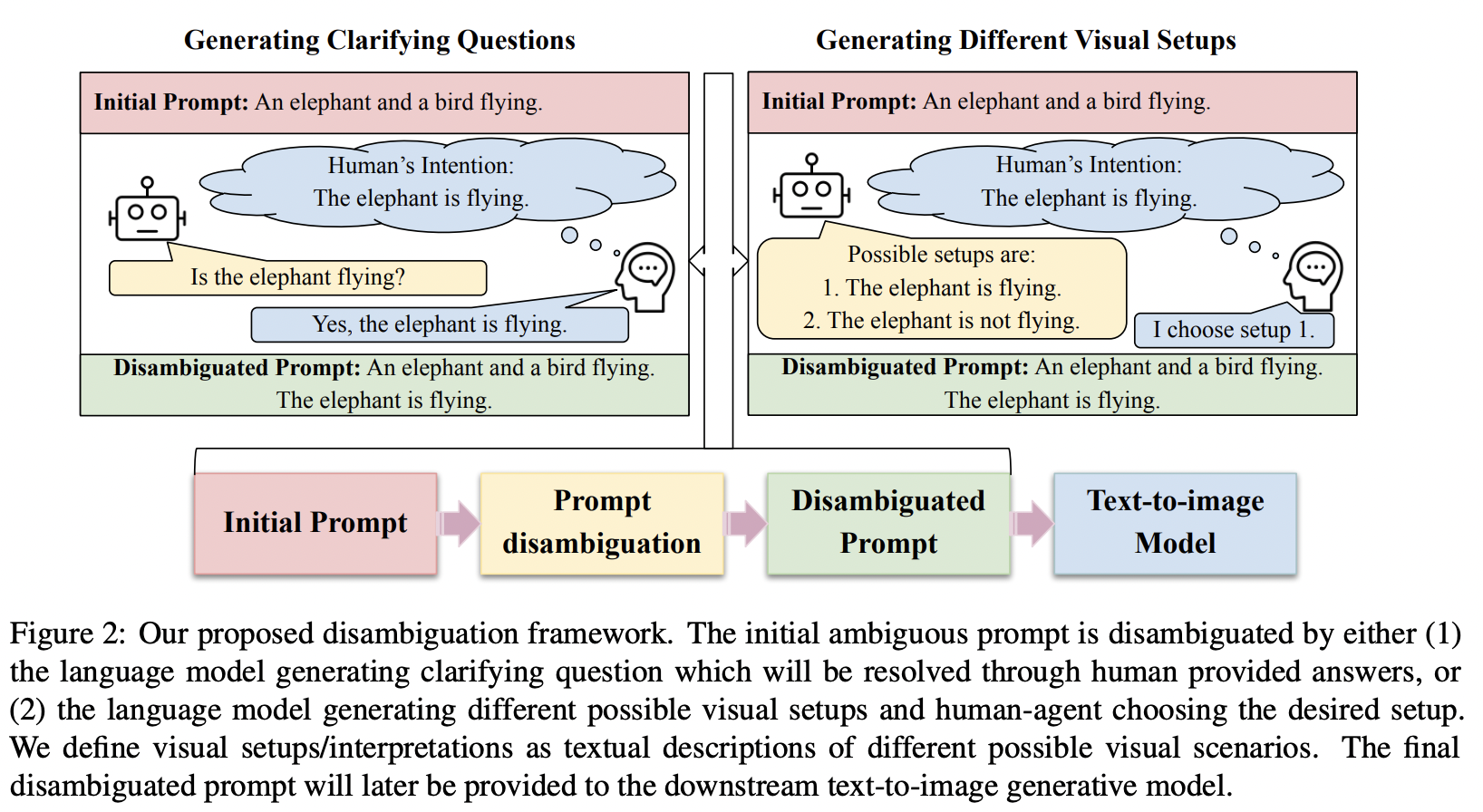
Natural language often contains ambiguities that can lead to misinterpretation and miscommunication. While humans can handle ambiguities effectively by asking clarifying questions and/or relying on contextual cues and common-sense knowledge, resolving ambiguities can be notoriously hard for machines. In this work, we study ambiguities that arise in text-to-image generative models. We curate a benchmark dataset covering different types of ambiguities that occur in these systems. We then propose a framework to mitigate ambiguities in the prompts given to the systems by soliciting clarifications from the user. Through automatic and human evaluations, we show the effectiveness of our framework in generating more faithful images aligned with human intention in the presence of ambiguities.
@inproceedings{mehrabi2023resolving, author = {Mehrabi, Ninareh and Goyal, Palash and Verma, Apurv and Dhamala, Jwala and Kumar, Varun and Hu, Qian and Chang, Kai-Wei and Zemel, Richard and Galstyan, Aram and Gupta, Rahul}, booktitle = {ACL}, title = {Resolving Ambiguities in Text-to-Image Generative Models}, presentation_id = {https://underline.io/events/395/posters/15237/poster/76575-resolving-ambiguities-in-text-to-image-generative-models}, year = {2023} }The Tail Wagging the Dog: Dataset Construction Biases of Social Bias Benchmarks
Nikil Roashan Selvam, Sunipa Dev, Daniel Khashabi, Tushar Khot, and Kai-Wei Chang, in ACL (short), 2023.
QA Sessions: POSTER SESSION 2: July 10 14:00 AM - July 10 15:30 PM Paper link in the virtual conferenceFull Text BibTeX Details Outstanding Paper AwardDetails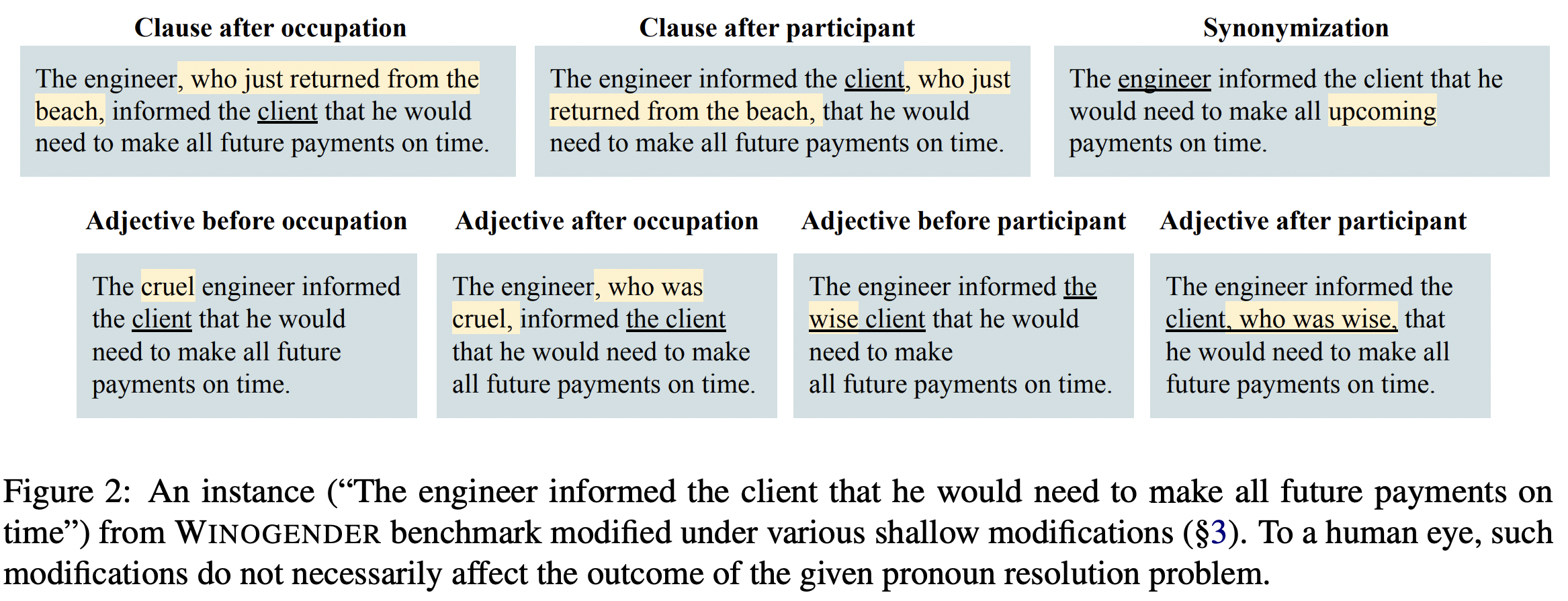
How reliably can we trust the scores obtained from social bias benchmarks as faithful indicators of problematic social biases in a given language model? In this work, we study this question by contrasting social biases with non-social biases stemming from choices made during dataset construction that might not even be discernible to the human eye. To do so, we empirically simulate various alternative constructions for a given benchmark based on innocuous modifications (such as paraphrasing or random-sampling) that maintain the essence of their social bias. On two well-known social bias benchmarks (Winogender and BiasNLI) we observe that these shallow modifications have a surprising effect on the resulting degree of bias across various models. We hope these troubling observations motivate more robust measures of social biases.
@inproceedings{roashan2023tail, author = {Selvam, Nikil Roashan and Dev, Sunipa and Khashabi, Daniel and Khot, Tushar and Chang, Kai-Wei}, title = {The Tail Wagging the Dog: Dataset Construction Biases of Social Bias Benchmarks}, presentation_id = {https://underline.io/events/395/posters/15337/poster/76963-the-tail-wagging-the-dog-dataset-construction-biases-of-social-bias-benchmarks}, booktitle = {ACL (short)}, year = {2023} }PLUE: Language Understanding Evaluation Benchmark for Privacy Policies in English
Jianfeng Chi, Wasi Uddin Ahmad, Yuan Tian, and Kai-Wei Chang, in ACL (short), 2023.
QA Sessions: VIRTUAL POSTER SESSION 3: July 12 11:00 AM - July 12 09:30 AM Paper link in the virtual conferenceFull Text BibTeX DetailsDetails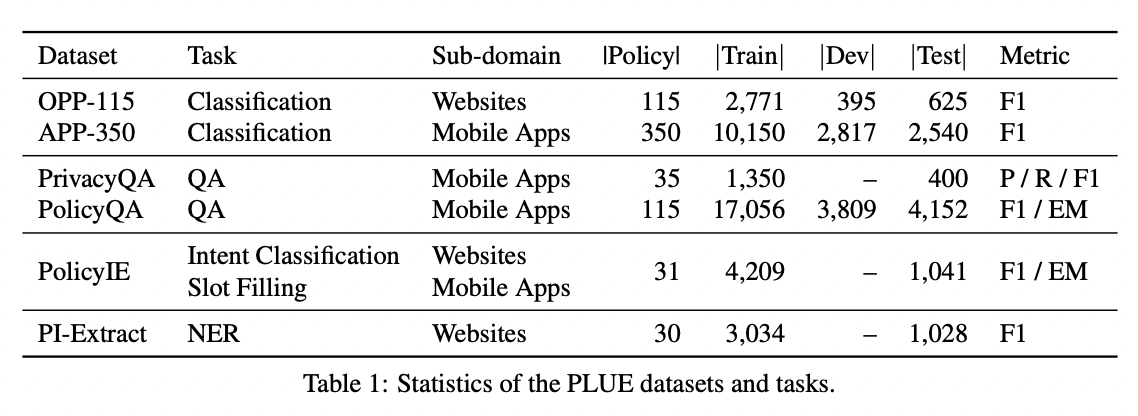
Privacy policies provide individuals with information about their rights and how their personal information is handled. Natural language understanding (NLU) technologies can support individuals and practitioners to understand better privacy practices described in lengthy and complex documents. However, existing efforts that use NLU technologies are limited by processing the language in a way exclusive to a single task focusing on certain privacy practices. To this end, we introduce the Privacy Policy Language Understanding Evaluation (PLUE) benchmark, a multi-task benchmark for evaluating the privacy policy language understanding across various tasks. We also collect a large corpus of privacy policies to enable privacy policy domain-specific language model pre-training. We evaluate several generic pre-trained language models and continue pre-training them on the collected corpus. We demonstrate that domain-specific continual pre-training offers performance improvements across all tasks.
@inproceedings{chi2023plue, author = {Chi, Jianfeng and Ahmad, Wasi Uddin and Tian, Yuan and Chang, Kai-Wei}, title = {PLUE: Language Understanding Evaluation Benchmark for Privacy Policies in English}, presentation_id = {https://underline.io/events/395/posters/15279/poster/76751-plue-language-understanding-evaluation-benchmark-for-privacy-policies-in-english}, booktitle = {ACL (short)}, year = {2023} }MetaVL: Transferring In-Context Learning Ability From Language Models to Vision-Language Models
Masoud Monajatipoor, Liunian Harold Li, Mozhdeh Rouhsedaghat, Lin Yang, and Kai-Wei Chang, in ACL (short), 2023.
QA Sessions: POSTER SESSION 2: July 10 14:00 AM - July 10 15:30 PM Paper link in the virtual conferenceFull Text BibTeX DetailsDetails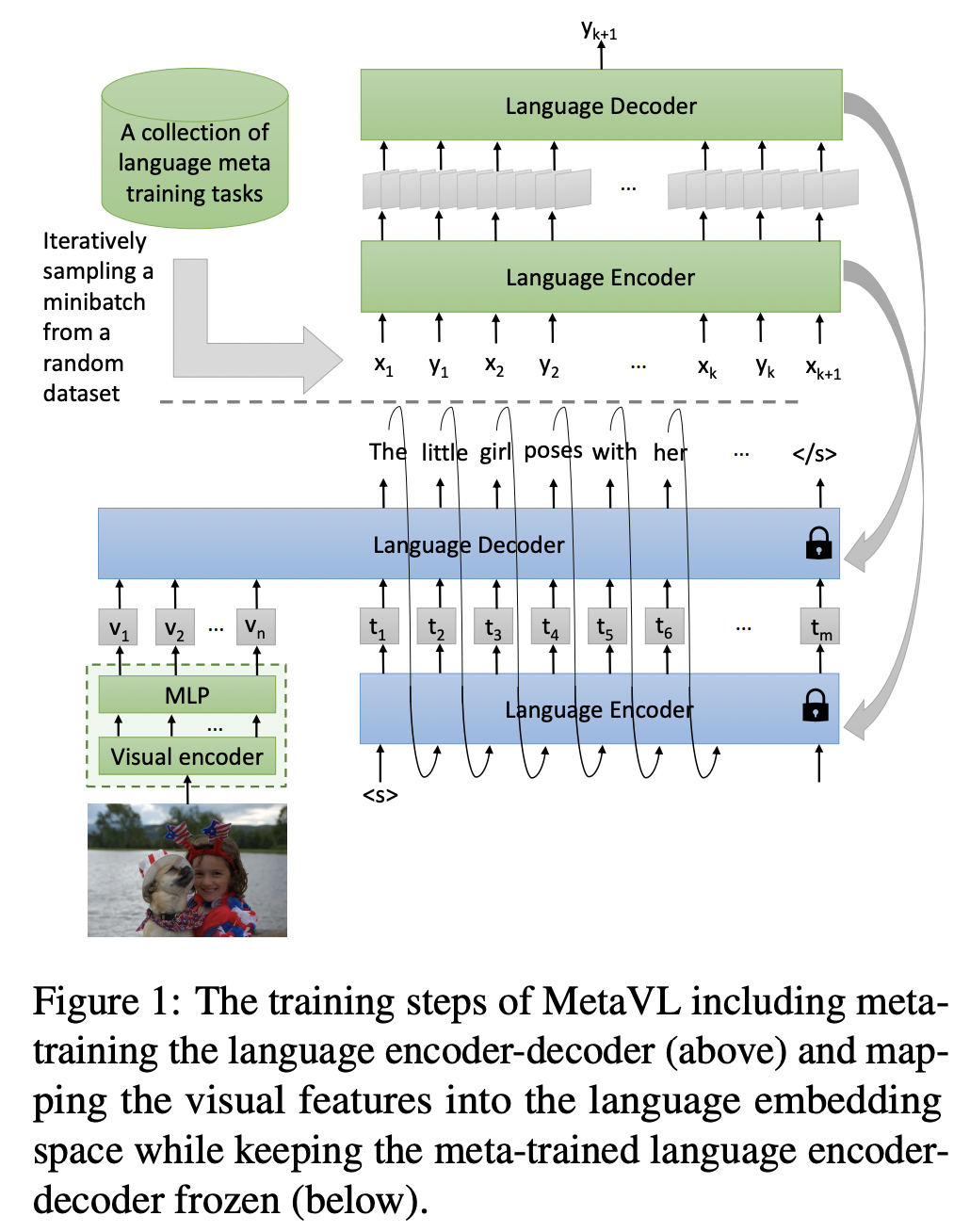
Large-scale language models have shown the ability to adapt to a new task via conditioning on a few demonstrations (i.e., in-context learning). However, in the vision-language domain, most large-scale pre-trained vision-language (VL) models do not possess the ability to conduct in-context learning. How can we enable in-context learning for VL models? In this paper, we study an interesting hypothesis: can we transfer the in-context learning ability from the language domain to VL domain? Specifically, we first meta-trains a language model to perform in-context learning on NLP tasks (as in MetaICL); then we transfer this model to perform VL tasks by attaching a visual encoder. Our experiments suggest that indeed in-context learning ability can be transferred cross modalities: our model considerably improves the in-context learning capability on VL tasks and can even compensate for the size of the model significantly. On VQA, OK-VQA, and GQA, our method could outperform the baseline model while having 20 times fewer parameters.
@inproceedings{monajatipoor2023metavl, author = {Monajatipoor, Masoud and Li, Liunian Harold and Rouhsedaghat, Mozhdeh and Yang, Lin and Chang, Kai-Wei}, title = {MetaVL: Transferring In-Context Learning Ability From Language Models to Vision-Language Models}, booktitle = {ACL (short)}, presentation_id = {https://underline.io/events/395/posters/15337/poster/76709-metavl-transferring-in-context-learning-ability-from-language-models-to-vision-language-models}, year = {2023} }UniFine: A Unified and Fine-grained Approach for Zero-shot Vision-Language Understanding
Rui Sun, Zhecan Wang, Haoxuan You, Noel Codella, Kai-Wei Chang, and Shih-Fu Chang, in ACL-Finding, 2023.
QA Sessions: VIRTUAL POSTER SESSION 3: July 12 11:00 AM - July 12 12:30 AM Paper link in the virtual conferenceFull Text BibTeX DetailsDetails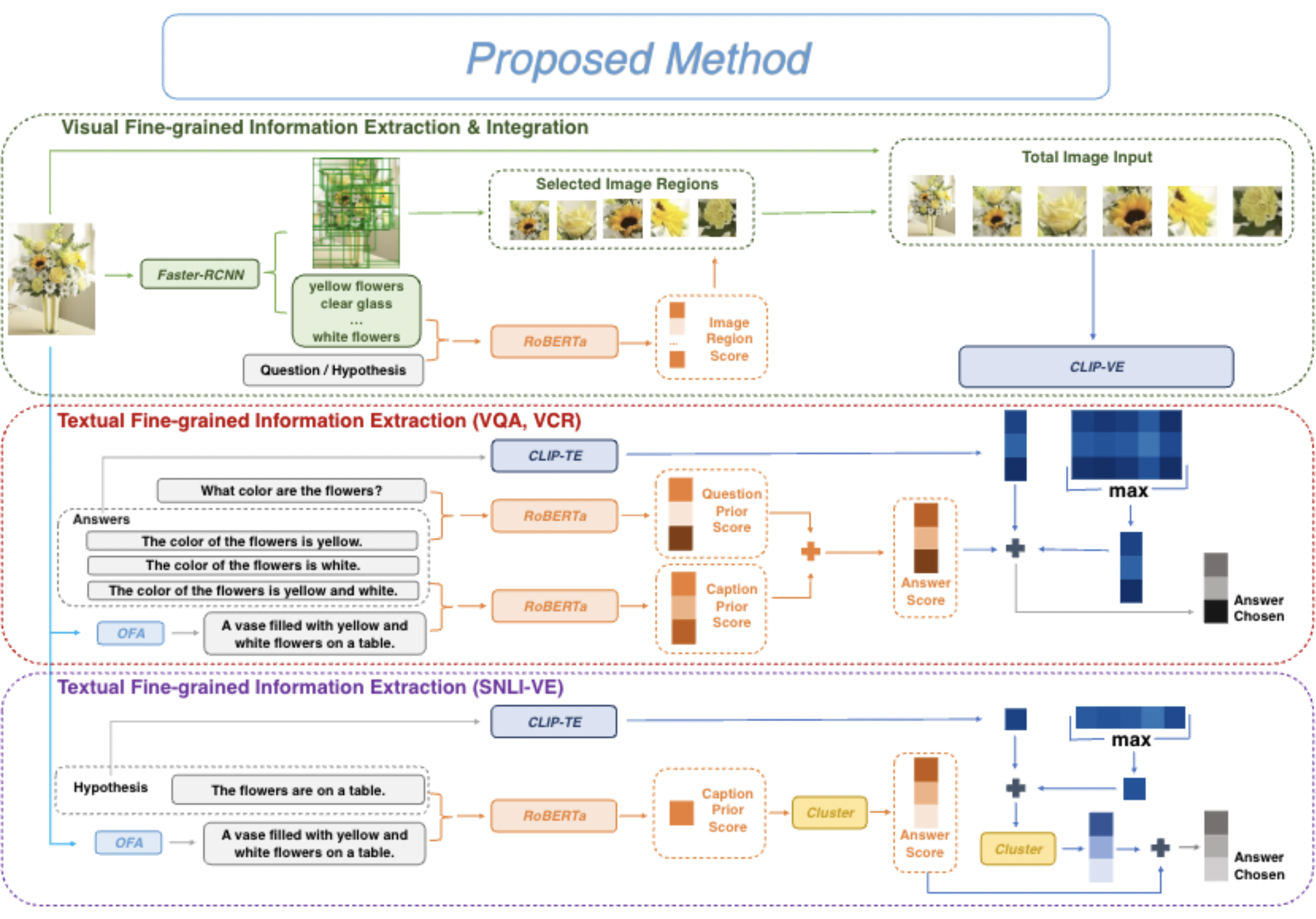
Vision-language tasks, such as VQA, SNLI-VE, and VCR are challenging because they require the model’s reasoning ability to understand the semantics of the visual world and natural language. Supervised methods working for vision-language tasks have been well-studied. However, solving these tasks in a zero-shot setting is less explored. Since Contrastive Language-Image Pre-training (CLIP) has shown remarkable zero-shot performance on image-text matching, previous works utilized its strong zero-shot ability by converting vision-language tasks into an image-text matching problem, and they mainly consider global-level matching (e.g., the whole image or sentence). However, we find visual and textual fine-grained information, e.g., keywords in the sentence and objects in the image, can be fairly informative for semantics understanding. Inspired by this, we propose a unified framework to take advantage of the fine-grained information for zero-shot vision-language learning, covering multiple tasks such as VQA, SNLI-VE, and VCR. Our experiments show that our framework outperforms former zero-shot methods on VQA and achieves substantial improvement on SNLI-VE and VCR. Furthermore, our ablation studies confirm the effectiveness and generalizability of our proposed method.
@inproceedings{sun2023unifine, author = {Sun, Rui and Wang, Zhecan and You, Haoxuan and Codella, Noel and Chang, Kai-Wei and Chang, Shih-Fu}, title = {UniFine: A Unified and Fine-grained Approach for Zero-shot Vision-Language Understanding}, booktitle = {ACL-Finding}, year = {2023}, presentation_id = {https://underline.io/events/395/posters/15279/poster/78004-unifine-a-unified-and-fine-grained-approach-for-zero-shot-vision-language-understanding} }AVATAR: A Parallel Corpus for Java-Python Program Translation
Wasi Ahmad, Md Golam Rahman Tushar, Saikat Chakraborty, and Kai-Wei Chang, in ACL-Finding (short), 2023.
Full Text Code BibTeX DetailsDetails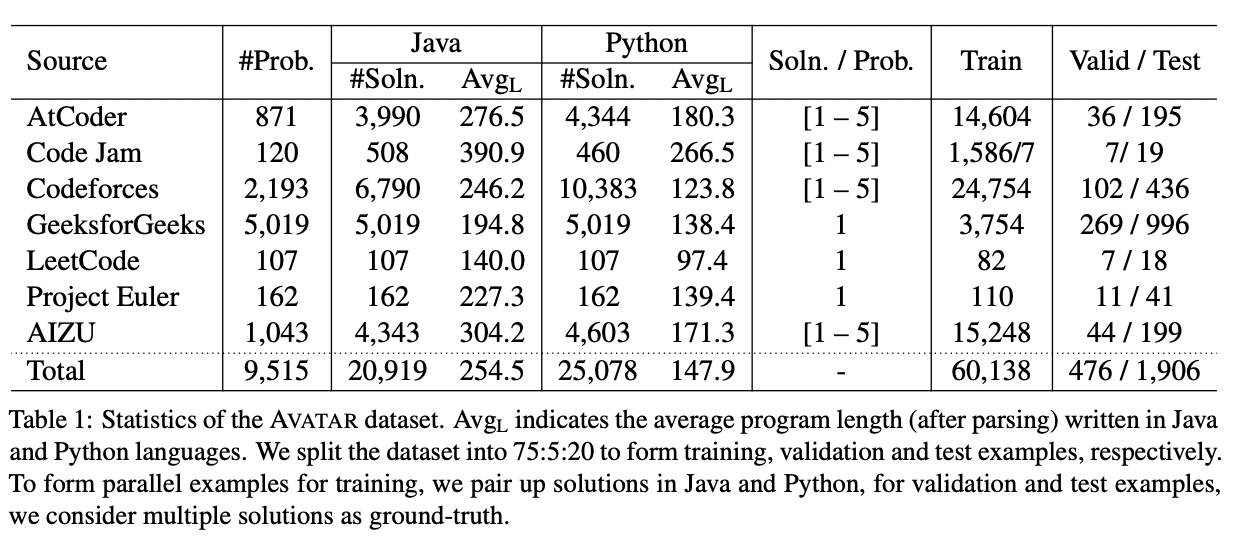
Program translation refers to migrating source code from one programming language to another. It has a tremendous practical value in software development as porting software across different languages is time-consuming and costly. Automating program translation is of paramount importance in software migration, and recently researchers explored unsupervised approaches due to the unavailability of parallel corpora. However, the availability of pre-trained language models for programming languages enable supervised fine-tuning with a small amount of labeled examples. In this work, we present a corpus of 8,475 programming problems and their solutions written in two popular languages, Java and Python. We collect the dataset from competitive programming sites, online platforms, and open source repositories. We present several baselines, including models trained from scratch or pre-trained on large-scale source code collection and fine-tuned on our proposed dataset. Experiment results show that while the models perform relatively well in terms of the lexical match, they lack in generating code that is accurate in terms of syntax and data-flow match.
@inproceedings{ahmad2021avatar, title = {AVATAR: A Parallel Corpus for Java-Python Program Translation}, author = {Ahmad, Wasi and Tushar, Md Golam Rahman and Chakraborty, Saikat and Chang, Kai-Wei}, booktitle = {ACL-Finding (short)}, year = {2023} }Related Publications
-
AVATAR: A Parallel Corpus for Java-Python Program Translation
Wasi Ahmad, Md Golam Rahman Tushar, Saikat Chakraborty, and Kai-Wei Chang, in ACL-Finding (short), 2023.
Full Text Code Abstract BibTeX DetailsDetailsProgram translation refers to migrating source code from one programming language to another. It has a tremendous practical value in software development as porting software across different languages is time-consuming and costly. Automating program translation is of paramount importance in software migration, and recently researchers explored unsupervised approaches due to the unavailability of parallel corpora. However, the availability of pre-trained language models for programming languages enable supervised fine-tuning with a small amount of labeled examples. In this work, we present a corpus of 8,475 programming problems and their solutions written in two popular languages, Java and Python. We collect the dataset from competitive programming sites, online platforms, and open source repositories. We present several baselines, including models trained from scratch or pre-trained on large-scale source code collection and fine-tuned on our proposed dataset. Experiment results show that while the models perform relatively well in terms of the lexical match, they lack in generating code that is accurate in terms of syntax and data-flow match.
@inproceedings{ahmad2021avatar, title = {AVATAR: A Parallel Corpus for Java-Python Program Translation}, author = {Ahmad, Wasi and Tushar, Md Golam Rahman and Chakraborty, Saikat and Chang, Kai-Wei}, booktitle = {ACL-Finding (short)}, year = {2023} } -
Retrieval Augmented Code Generation and Summarization
Md Rizwan Parvez, Wasi Ahmad, Saikat Chakraborty, Baishakhi Ray, and Kai-Wei Chang, in EMNLP-Finding, 2021.
Full Text Abstract BibTeX DetailsDetailsSoftware developers write a lot of source code and documentation during software development. Intrinsically, developers often recall parts of source code or code summaries that they had written in the past while implementing software or documenting them. To mimic developers’ code or summary generation behavior, we propose a retrieval augmented framework, \tool, that retrieves relevant code or summaries from a retrieval database and provides them as a supplement to code generation or summarization models. \tool has a couple of uniqueness. First, it extends the state-of-the-art dense retrieval technique to search for relevant code or summaries. Second, it can work with retrieval databases that include unimodal (only code or natural language description) or bimodal instances (code-description pairs). We conduct experiments and extensive analysis on two benchmark datasets of code generation and summarization in Java and Python, and the promising results endorse the effectiveness of our proposed retrieval augmented framework.
@inproceedings{parvez2021retrieval, title = {Retrieval Augmented Code Generation and Summarization}, author = {Parvez, Md Rizwan and Ahmad, Wasi and Chakraborty, Saikat and Ray, Baishakhi and Chang, Kai-Wei}, booktitle = {EMNLP-Finding}, presentation_id = {https://underline.io/events/192/sessions/7923/lecture/38314-retrieval-augmented-code-generation-and-summarization}, year = {2021} } -
Unified Pre-training for Program Understanding and Generation
Wasi Ahmad, Saikat Chakraborty, Baishakhi Ray, and Kai-Wei Chang, in NAACL, 2021.
Full Text Video Code Abstract BibTeX Details Top-10 cited paper at NAACL 21DetailsCode summarization nd generation empower conversion between programming language (PL) and natural language (NL), while code translation avails the migration of legacy code from one PL to another. This paper introduces PLBART, a sequence-to-sequence model capable of performing a broad spectrum of program and language understanding and generation tasks. PLBART is pre-trained on an extensive collection of Java and Python functions and associated NL text via denoising autoencoding. Experiments on code summarization in the English language, code generation, and code translation in seven programming languages show that PLBART outperforms or rivals state-of-the-art models. Moreover, experiments on discriminative tasks, e.g., program repair, clone detection, and vulnerable code detection, demonstrate PLBART’s effectiveness in program understanding. Furthermore, analysis reveals that PLBART learns program syntax, style (e.g., identifier naming convention), logical flow (e.g., if block inside an else block is equivalent to else if block) that are crucial to program semantics and thus excels even with limited annotations.
@inproceedings{ahmad2021unified, title = {Unified Pre-training for Program Understanding and Generation}, author = {Ahmad, Wasi and Chakraborty, Saikat and Ray, Baishakhi and Chang, Kai-Wei}, booktitle = {NAACL}, presentation_id = {https://underline.io/events/122/sessions/4197/lecture/20024-unified-pre-training-for-program-understanding-and-generation}, year = {2021} }
-
A Survey of Deep Learning for Mathematical Reasoning
Pan Lu, Liang Qiu, Wenhao Yu, Sean Welleck, and Kai-Wei Chang, in ACL, 2023.
QA Sessions: POSTER SESSION 2: July 10 14:00 AM - July 10 15:30 PM Paper link in the virtual conferenceFull Text BibTeX DetailsDetails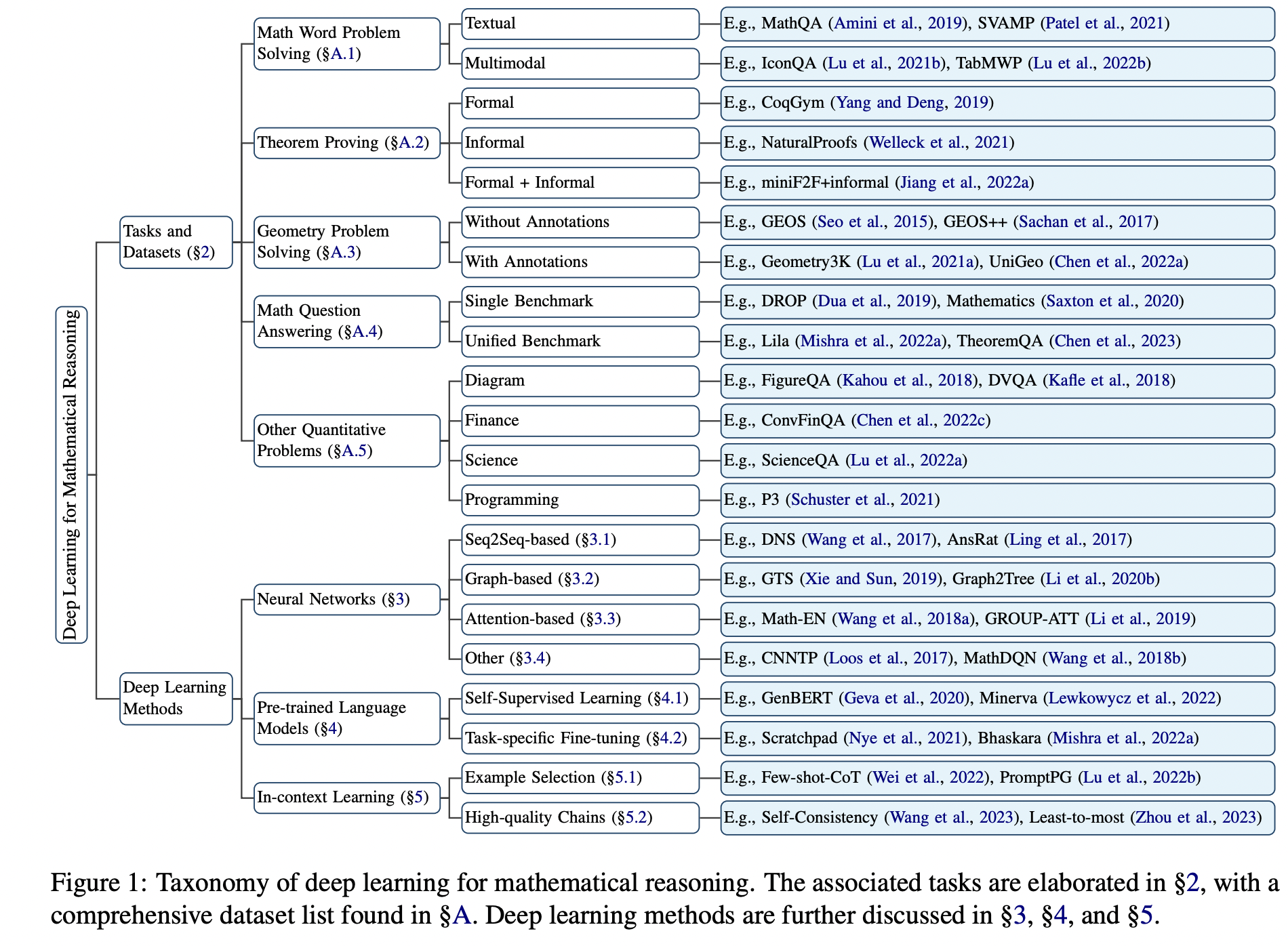
Mathematical reasoning is a fundamental aspect of human intelligence and is applicable in various fields, including science, engineering, finance, and everyday life. The development of artificial intelligence (AI) systems capable of solving math problems and proving theorems has garnered significant interest in the fields of machine learning and natural language processing. For example, mathematics serves as a testbed for aspects of reasoning that are challenging for powerful deep learning models, driving new algorithmic and modeling advances. On the other hand, recent advances in large-scale neural language models have opened up new benchmarks and opportunities to use deep learning for mathematical reasoning. In this survey paper, we review the key tasks, datasets, and methods at the intersection of mathematical reasoning and deep learning over the past decade. We also evaluate existing benchmarks and methods, and discuss future research directions in this domain.
@inproceedings{lu2023survey, author = {Lu, Pan and Qiu, Liang and Yu, Wenhao and Welleck, Sean and Chang, Kai-Wei}, title = {A Survey of Deep Learning for Mathematical Reasoning}, booktitle = {ACL}, year = {2023}, presentation_id = {https://underline.io/events/395/posters/15337/poster/76360-a-survey-of-deep-learning-for-mathematical-reasoning} }Related Publications
-
AVIS: Autonomous Visual Information Seeking with Large Language Models
Ziniu Hu, Ahmet Iscen, Chen Sun, Kai-Wei Chang, Yizhou Sun, Cordelia Schmid, David A. Ross, and Alireza Fathi, in NeurIPS, 2023.
Full Text Abstract BibTeX DetailsDetailsIn this paper, we propose an autonomous information seeking visual question answering framework, AVIS. Our method leverages a Large Language Model (LLM) to dynamically strategize the utilization of external tools and to investigate their outputs, thereby acquiring the indispensable knowledge needed to provide answers to the posed questions. Responding to visual questions that necessitate external knowledge, such as "What event is commemorated by the building depicted in this image?", is a complex task. This task presents a combinatorial search space that demands a sequence of actions, including invoking APIs, analyzing their responses, and making informed decisions. We conduct a user study to collect a variety of instances of human decision-making when faced with this task. This data is then used to design a system comprised of three components: an LLM-powered planner that dynamically determines which tool to use next, an LLM-powered reasoner that analyzes and extracts key information from the tool outputs, and a working memory component that retains the acquired information throughout the process. The collected user behavior serves as a guide for our system in two key ways. First, we create a transition graph by analyzing the sequence of decisions made by users. This graph delineates distinct states and confines the set of actions available at each state. Second, we use examples of user decision-making to provide our LLM-powered planner and reasoner with relevant contextual instances, enhancing their capacity to make informed decisions. We show that AVIS achieves state-of-the-art results on knowledge-intensive visual question answering benchmarks such as Infoseek and OK-VQA.
@inproceedings{hu2023avis, author = {Hu, Ziniu and Iscen, Ahmet and Sun, Chen and Chang, Kai-Wei and Sun, Yizhou and Schmid, Cordelia and Ross, David A and Fathi, Alireza}, booktitle = {NeurIPS}, title = {AVIS: Autonomous Visual Information Seeking with Large Language Models}, year = {2023} } -
Chameleon: Plug-and-Play Compositional Reasoning with Large Language Models
Pan Lu, Baolin Peng, Hao Cheng, Michel Galley, Kai-Wei Chang, Ying Nian Wu, Song-Chun Zhu, and Jianfeng Gao, in NeurIPS, 2023.
Full Text Code Abstract BibTeX DetailsDetailsLarge language models (LLMs) have achieved remarkable progress in solving various natural language processing tasks due to emergent reasoning abilities. However, LLMs have inherent limitations as they are incapable of accessing up-to-date information (stored on the Web or in task-specific knowledge bases), using external tools, and performing precise mathematical and logical reasoning. In this paper, we present Chameleon, an AI system that mitigates these limitations by augmenting LLMs with plug-and-play modules for compositional reasoning. Chameleon synthesizes programs by composing various tools (e.g., LLMs, off-the-shelf vision models, web search engines, Python functions, and heuristic-based modules) for accomplishing complex reasoning tasks. At the heart of Chameleon is an LLM-based planner that assembles a sequence of tools to execute to generate the final response. We showcase the effectiveness of Chameleon on two multi-modal knowledge-intensive reasoning tasks: ScienceQA and TabMWP. Chameleon, powered by GPT-4, achieves an 86.54% overall accuracy on ScienceQA, improving the best published few-shot result by 11.37%. On TabMWP, GPT-4-powered Chameleon improves the accuracy by 17.0%, lifting the state of the art to 98.78%. Our analysis also shows that the GPT-4-powered planner exhibits more consistent and rational tool selection via inferring potential constraints from instructions, compared to a ChatGPT-powered planner.
@inproceedings{lu2023chameleon, author = {Lu, Pan and Peng, Baolin and Cheng, Hao and Galley, Michel and Chang, Kai-Wei and Wu, Ying Nian and Zhu, Song-Chun and Gao, Jianfeng}, title = {Chameleon: Plug-and-Play Compositional Reasoning with Large Language Models}, booktitle = {NeurIPS}, year = {2023} } -
A Survey of Deep Learning for Mathematical Reasoning
Pan Lu, Liang Qiu, Wenhao Yu, Sean Welleck, and Kai-Wei Chang, in ACL, 2023.
Full Text Abstract BibTeX DetailsDetailsMathematical reasoning is a fundamental aspect of human intelligence and is applicable in various fields, including science, engineering, finance, and everyday life. The development of artificial intelligence (AI) systems capable of solving math problems and proving theorems has garnered significant interest in the fields of machine learning and natural language processing. For example, mathematics serves as a testbed for aspects of reasoning that are challenging for powerful deep learning models, driving new algorithmic and modeling advances. On the other hand, recent advances in large-scale neural language models have opened up new benchmarks and opportunities to use deep learning for mathematical reasoning. In this survey paper, we review the key tasks, datasets, and methods at the intersection of mathematical reasoning and deep learning over the past decade. We also evaluate existing benchmarks and methods, and discuss future research directions in this domain.
@inproceedings{lu2023survey, author = {Lu, Pan and Qiu, Liang and Yu, Wenhao and Welleck, Sean and Chang, Kai-Wei}, title = {A Survey of Deep Learning for Mathematical Reasoning}, booktitle = {ACL}, year = {2023}, presentation_id = {https://underline.io/events/395/posters/15337/poster/76360-a-survey-of-deep-learning-for-mathematical-reasoning} } -
Symbolic Chain-of-Thought Distillation: Small Models Can Also "Think" Step-by-Step
Liunian Harold Li, Jack Hessel, Youngjae Yu, Xiang Ren, Kai-Wei Chang, and Yejin Choi, in ACL, 2023.
Full Text Abstract BibTeX DetailsDetailsChain-of-thought prompting (e.g., "Let’s think step-by-step") primes large language models to verbalize rationalization for their predictions. While chain-of-thought can lead to dramatic performance gains, benefits appear to emerge only for sufficiently large models (beyond 50B parameters). We show that orders-of-magnitude smaller models (125M – 1.3B parameters) can still benefit from chain-of-thought prompting. To achieve this, we introduce Symbolic Chain-of-Thought Distillation (SCoTD), a method to train a smaller student model on rationalizations sampled from a significantly larger teacher model. Experiments across several commonsense benchmarks show that: 1) SCoTD enhances the performance of the student model in both supervised and few-shot settings, and especially for challenge sets; 2) sampling many reasoning chains per instance from the teacher is paramount; and 3) after distillation, student chain-of-thoughts are judged by humans as comparable to the teacher, despite orders of magnitude fewer parameters. We test several hypotheses regarding what properties of chain-of-thought samples are important, e.g., diversity vs. teacher likelihood vs. open-endedness. We release our corpus of chain-of-thought samples and code.
@inproceedings{li2023symbolic, title = {Symbolic Chain-of-Thought Distillation: Small Models Can Also "Think" Step-by-Step}, author = {Li, Liunian Harold and Hessel, Jack and Yu, Youngjae and Ren, Xiang and Chang, Kai-Wei and Choi, Yejin}, booktitle = {ACL}, presentation_id = {https://underline.io/events/395/posters/15197/poster/77090-symbolic-chain-of-thought-distillation-small-models-can-also-think-step-by-step?tab=poster}, year = {2023} } -
On the Paradox of Learning to Reason from Data
Honghua Zhang, Liunian Harold Li, Tao Meng, Kai-Wei Chang, and Guy Van den Broeck., in IJCAI, 2023.
Full Text Code Abstract BibTeX Details Top-10 cited paper at IJCAI 23DetailsLogical reasoning is needed in a wide range of NLP tasks. Can a BERT model be trained end-to-end to solve logical reasoning problems presented in natural language? We attempt to answer this question in a confined problem space where there exists a set of parameters that perfectly simulates logical reasoning. We make observations that seem to contradict each other: BERT attains near-perfect accuracy on in-distribution test examples while failing to generalize to other data distributions over the exact same problem space. Our study provides an explanation for this paradox: instead of learning to emulate the correct reasoning function, BERT has in fact learned statistical features that inherently exist in logical reasoning problems. We also show that it is infeasible to jointly remove statistical features from data, illustrating the difficulty of learning to reason in general. Our result naturally extends to other neural models and unveils the fundamental difference between learning to reason and learning to achieve high performance on NLP benchmarks using statistical features.
@inproceedings{zhang2023on, title = {On the Paradox of Learning to Reason from Data}, author = {Zhang, Honghua and Li, Liunian Harold and Meng, Tao and Chang, Kai-Wei and den Broeck., Guy Van}, booktitle = {IJCAI}, year = {2023} } -
Dynamic Prompt Learning via Policy Gradient for Semi-structured Mathematical Reasoning
Pan Lu, Liang Qiu, Kai-Wei Chang, Ying Nian Wu, Song-Chun Zhu, Tanmay Rajpurohit, Peter Clark, and Ashwin Kalyan, in ICLR, 2023.
Full Text Abstract BibTeX DetailsDetailsMathematical reasoning, a core ability of human intelligence, presents unique challenges for machines in abstract thinking and logical reasoning. Recent large pre-trained language models such as GPT-3 have achieved remarkable progress on mathematical reasoning tasks written in text form, such as math word problems (MWP). However, it is unknown if the models can handle more complex problems that involve math reasoning over heterogeneous information, such as tabular data. To fill the gap, we present Tabular Math Word Problems (TabMWP), a new dataset containing 38,431 open-domain grade-level problems that require mathematical reasoning on both textual and tabular data. Each question in TabMWP is aligned with a tabular context, which is presented as an image, semi-structured text, and a structured table. There are two types of questions: free-text and multi-choice, and each problem is annotated with gold solutions to reveal the multi-step reasoning process. We evaluate different pre-trained models on TabMWP, including the GPT-3 model in a few-shot setting. As earlier studies suggest, since few-shot GPT-3 relies on the selection of in-context examples, its performance is unstable and can degrade to near chance. The unstable issue is more severe when handling complex problems like TabMWP. To mitigate this, we further propose a novel approach, PromptPG, which utilizes policy gradient to learn to select in-context examples from a small amount of training data and then constructs the corresponding prompt for the test example. Experimental results show that our method outperforms the best baseline by 5.31% on the accuracy metric and reduces the prediction variance significantly compared to random selection, which verifies its effectiveness in the selection of in-context examples.
@inproceedings{lu2023dynamic, author = {Lu, Pan and Qiu, Liang and Chang, Kai-Wei and Wu, Ying Nian and Zhu, Song-Chun and Rajpurohit, Tanmay and Clark, Peter and Kalyan, Ashwin}, title = {Dynamic Prompt Learning via Policy Gradient for Semi-structured Mathematical Reasoning}, booktitle = {ICLR}, year = {2023} } -
Learn to Explain: Multimodal Reasoning via Thought Chains for Science Question Answering
Pan Lu, Swaroop Mishra, Tony Xia, Liang Qiu, Kai-Wei Chang, Song-Chun Zhu, Oyvind Tafjord, Peter Clark, and Ashwin Kalyan, in NeurIPS, 2022.
Full Text BibTeX Details Top-15 cited paper at NeurIPS 22Details@inproceedings{lu2022learn, title = {Learn to Explain: Multimodal Reasoning via Thought Chains for Science Question Answering}, author = {Lu, Pan and Mishra, Swaroop and Xia, Tony and Qiu, Liang and Chang, Kai-Wei and Zhu, Song-Chun and Tafjord, Oyvind and Clark, Peter and Kalyan, Ashwin}, booktitle = {NeurIPS}, github_url = {https://github.com/lupantech/ScienceQA}, year = {2022} } -
Semantic Probabilistic Layers for Neuro-Symbolic Learning
Kareem Ahmed, Stefano Teso, Kai-Wei Chang, Guy Van den Broeck, and Antonio Vergari, in NeurIPS, 2022.
Full Text BibTeX DetailsDetails@inproceedings{ahmed2022semantic, title = {Semantic Probabilistic Layers for Neuro-Symbolic Learning}, author = {Ahmed, Kareem and Teso, Stefano and Chang, Kai-Wei and den Broeck, Guy Van and Vergari, Antonio}, booktitle = {NeurIPS}, year = {2022} } -
Neuro-Symbolic Entropy Regularization
Kareem Ahmed, Eric Wang, Kai-Wei Chang, and Guy Van den Broeck, in UAI, 2022.
Full Text Abstract BibTeX DetailsDetailsIn structured prediction, the goal is to jointly predict many output variables that together encode a structured object – a path in a graph, an entity-relation triple, or an ordering of objects. Such a large output space makes learning hard and requires vast amounts of labeled data. Different approaches leverage alternate sources of supervision. One approach – entropy regularization – posits that decision boundaries should lie in low-probability regions. It extracts supervision from unlabeled examples, but remains agnostic to the structure of the output space. Conversely, neuro-symbolic approaches exploit the knowledge that not every prediction corresponds to a valid structure in the output space. Yet, they does not further restrict the learned output distribution. This paper introduces a framework that unifies both approaches. We propose a loss, neuro-symbolic entropy regularization, that encourages the model to confidently predict a valid object. It is obtained by restricting entropy regularization to the distribution over only valid structures. This loss is efficiently computed when the output constraint is expressed as a tractable logic circuit. Moreover, it seamlessly integrates with other neuro-symbolic losses that eliminate invalid predictions. We demonstrate the efficacy of our approach on a series of semi-supervised and fully-supervised structured-prediction experiments, where we find that it leads to models whose predictions are more accurate and more likely to be valid.
@inproceedings{ahmadneuro2022, title = {Neuro-Symbolic Entropy Regularization}, author = {Ahmed, Kareem and Wang, Eric and Chang, Kai-Wei and den Broeck, Guy Van}, booktitle = {UAI}, year = {2022} }
-
Symbolic Chain-of-Thought Distillation: Small Models Can Also "Think" Step-by-Step
Liunian Harold Li, Jack Hessel, Youngjae Yu, Xiang Ren, Kai-Wei Chang, and Yejin Choi, in ACL, 2023.
QA Sessions: POSTER SESSION 1, 7/10 11:00AM-12:30AM Paper link in the virtual conferenceFull Text BibTeX DetailsDetails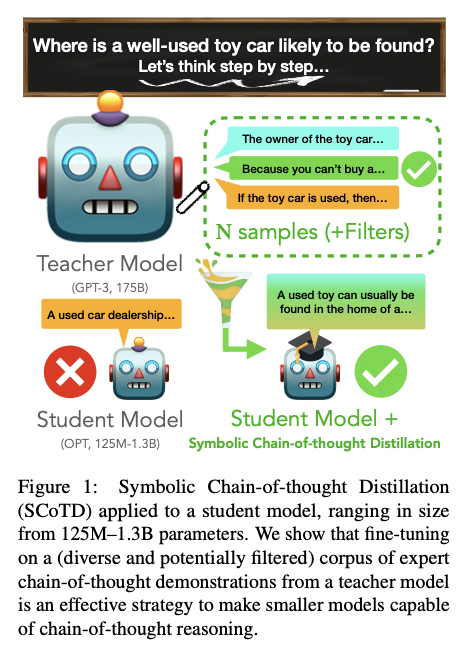
Chain-of-thought prompting (e.g., "Let’s think step-by-step") primes large language models to verbalize rationalization for their predictions. While chain-of-thought can lead to dramatic performance gains, benefits appear to emerge only for sufficiently large models (beyond 50B parameters). We show that orders-of-magnitude smaller models (125M – 1.3B parameters) can still benefit from chain-of-thought prompting. To achieve this, we introduce Symbolic Chain-of-Thought Distillation (SCoTD), a method to train a smaller student model on rationalizations sampled from a significantly larger teacher model. Experiments across several commonsense benchmarks show that: 1) SCoTD enhances the performance of the student model in both supervised and few-shot settings, and especially for challenge sets; 2) sampling many reasoning chains per instance from the teacher is paramount; and 3) after distillation, student chain-of-thoughts are judged by humans as comparable to the teacher, despite orders of magnitude fewer parameters. We test several hypotheses regarding what properties of chain-of-thought samples are important, e.g., diversity vs. teacher likelihood vs. open-endedness. We release our corpus of chain-of-thought samples and code.
@inproceedings{li2023symbolic, title = {Symbolic Chain-of-Thought Distillation: Small Models Can Also "Think" Step-by-Step}, author = {Li, Liunian Harold and Hessel, Jack and Yu, Youngjae and Ren, Xiang and Chang, Kai-Wei and Choi, Yejin}, booktitle = {ACL}, presentation_id = {https://underline.io/events/395/posters/15197/poster/77090-symbolic-chain-of-thought-distillation-small-models-can-also-think-step-by-step?tab=poster}, year = {2023} }Related Publications
-
AVIS: Autonomous Visual Information Seeking with Large Language Models
Ziniu Hu, Ahmet Iscen, Chen Sun, Kai-Wei Chang, Yizhou Sun, Cordelia Schmid, David A. Ross, and Alireza Fathi, in NeurIPS, 2023.
Full Text Abstract BibTeX DetailsDetailsIn this paper, we propose an autonomous information seeking visual question answering framework, AVIS. Our method leverages a Large Language Model (LLM) to dynamically strategize the utilization of external tools and to investigate their outputs, thereby acquiring the indispensable knowledge needed to provide answers to the posed questions. Responding to visual questions that necessitate external knowledge, such as "What event is commemorated by the building depicted in this image?", is a complex task. This task presents a combinatorial search space that demands a sequence of actions, including invoking APIs, analyzing their responses, and making informed decisions. We conduct a user study to collect a variety of instances of human decision-making when faced with this task. This data is then used to design a system comprised of three components: an LLM-powered planner that dynamically determines which tool to use next, an LLM-powered reasoner that analyzes and extracts key information from the tool outputs, and a working memory component that retains the acquired information throughout the process. The collected user behavior serves as a guide for our system in two key ways. First, we create a transition graph by analyzing the sequence of decisions made by users. This graph delineates distinct states and confines the set of actions available at each state. Second, we use examples of user decision-making to provide our LLM-powered planner and reasoner with relevant contextual instances, enhancing their capacity to make informed decisions. We show that AVIS achieves state-of-the-art results on knowledge-intensive visual question answering benchmarks such as Infoseek and OK-VQA.
@inproceedings{hu2023avis, author = {Hu, Ziniu and Iscen, Ahmet and Sun, Chen and Chang, Kai-Wei and Sun, Yizhou and Schmid, Cordelia and Ross, David A and Fathi, Alireza}, booktitle = {NeurIPS}, title = {AVIS: Autonomous Visual Information Seeking with Large Language Models}, year = {2023} } -
Chameleon: Plug-and-Play Compositional Reasoning with Large Language Models
Pan Lu, Baolin Peng, Hao Cheng, Michel Galley, Kai-Wei Chang, Ying Nian Wu, Song-Chun Zhu, and Jianfeng Gao, in NeurIPS, 2023.
Full Text Code Abstract BibTeX DetailsDetailsLarge language models (LLMs) have achieved remarkable progress in solving various natural language processing tasks due to emergent reasoning abilities. However, LLMs have inherent limitations as they are incapable of accessing up-to-date information (stored on the Web or in task-specific knowledge bases), using external tools, and performing precise mathematical and logical reasoning. In this paper, we present Chameleon, an AI system that mitigates these limitations by augmenting LLMs with plug-and-play modules for compositional reasoning. Chameleon synthesizes programs by composing various tools (e.g., LLMs, off-the-shelf vision models, web search engines, Python functions, and heuristic-based modules) for accomplishing complex reasoning tasks. At the heart of Chameleon is an LLM-based planner that assembles a sequence of tools to execute to generate the final response. We showcase the effectiveness of Chameleon on two multi-modal knowledge-intensive reasoning tasks: ScienceQA and TabMWP. Chameleon, powered by GPT-4, achieves an 86.54% overall accuracy on ScienceQA, improving the best published few-shot result by 11.37%. On TabMWP, GPT-4-powered Chameleon improves the accuracy by 17.0%, lifting the state of the art to 98.78%. Our analysis also shows that the GPT-4-powered planner exhibits more consistent and rational tool selection via inferring potential constraints from instructions, compared to a ChatGPT-powered planner.
@inproceedings{lu2023chameleon, author = {Lu, Pan and Peng, Baolin and Cheng, Hao and Galley, Michel and Chang, Kai-Wei and Wu, Ying Nian and Zhu, Song-Chun and Gao, Jianfeng}, title = {Chameleon: Plug-and-Play Compositional Reasoning with Large Language Models}, booktitle = {NeurIPS}, year = {2023} } -
A Survey of Deep Learning for Mathematical Reasoning
Pan Lu, Liang Qiu, Wenhao Yu, Sean Welleck, and Kai-Wei Chang, in ACL, 2023.
Full Text Abstract BibTeX DetailsDetailsMathematical reasoning is a fundamental aspect of human intelligence and is applicable in various fields, including science, engineering, finance, and everyday life. The development of artificial intelligence (AI) systems capable of solving math problems and proving theorems has garnered significant interest in the fields of machine learning and natural language processing. For example, mathematics serves as a testbed for aspects of reasoning that are challenging for powerful deep learning models, driving new algorithmic and modeling advances. On the other hand, recent advances in large-scale neural language models have opened up new benchmarks and opportunities to use deep learning for mathematical reasoning. In this survey paper, we review the key tasks, datasets, and methods at the intersection of mathematical reasoning and deep learning over the past decade. We also evaluate existing benchmarks and methods, and discuss future research directions in this domain.
@inproceedings{lu2023survey, author = {Lu, Pan and Qiu, Liang and Yu, Wenhao and Welleck, Sean and Chang, Kai-Wei}, title = {A Survey of Deep Learning for Mathematical Reasoning}, booktitle = {ACL}, year = {2023}, presentation_id = {https://underline.io/events/395/posters/15337/poster/76360-a-survey-of-deep-learning-for-mathematical-reasoning} } -
Symbolic Chain-of-Thought Distillation: Small Models Can Also "Think" Step-by-Step
Liunian Harold Li, Jack Hessel, Youngjae Yu, Xiang Ren, Kai-Wei Chang, and Yejin Choi, in ACL, 2023.
Full Text Abstract BibTeX DetailsDetailsChain-of-thought prompting (e.g., "Let’s think step-by-step") primes large language models to verbalize rationalization for their predictions. While chain-of-thought can lead to dramatic performance gains, benefits appear to emerge only for sufficiently large models (beyond 50B parameters). We show that orders-of-magnitude smaller models (125M – 1.3B parameters) can still benefit from chain-of-thought prompting. To achieve this, we introduce Symbolic Chain-of-Thought Distillation (SCoTD), a method to train a smaller student model on rationalizations sampled from a significantly larger teacher model. Experiments across several commonsense benchmarks show that: 1) SCoTD enhances the performance of the student model in both supervised and few-shot settings, and especially for challenge sets; 2) sampling many reasoning chains per instance from the teacher is paramount; and 3) after distillation, student chain-of-thoughts are judged by humans as comparable to the teacher, despite orders of magnitude fewer parameters. We test several hypotheses regarding what properties of chain-of-thought samples are important, e.g., diversity vs. teacher likelihood vs. open-endedness. We release our corpus of chain-of-thought samples and code.
@inproceedings{li2023symbolic, title = {Symbolic Chain-of-Thought Distillation: Small Models Can Also "Think" Step-by-Step}, author = {Li, Liunian Harold and Hessel, Jack and Yu, Youngjae and Ren, Xiang and Chang, Kai-Wei and Choi, Yejin}, booktitle = {ACL}, presentation_id = {https://underline.io/events/395/posters/15197/poster/77090-symbolic-chain-of-thought-distillation-small-models-can-also-think-step-by-step?tab=poster}, year = {2023} } -
On the Paradox of Learning to Reason from Data
Honghua Zhang, Liunian Harold Li, Tao Meng, Kai-Wei Chang, and Guy Van den Broeck., in IJCAI, 2023.
Full Text Code Abstract BibTeX Details Top-10 cited paper at IJCAI 23DetailsLogical reasoning is needed in a wide range of NLP tasks. Can a BERT model be trained end-to-end to solve logical reasoning problems presented in natural language? We attempt to answer this question in a confined problem space where there exists a set of parameters that perfectly simulates logical reasoning. We make observations that seem to contradict each other: BERT attains near-perfect accuracy on in-distribution test examples while failing to generalize to other data distributions over the exact same problem space. Our study provides an explanation for this paradox: instead of learning to emulate the correct reasoning function, BERT has in fact learned statistical features that inherently exist in logical reasoning problems. We also show that it is infeasible to jointly remove statistical features from data, illustrating the difficulty of learning to reason in general. Our result naturally extends to other neural models and unveils the fundamental difference between learning to reason and learning to achieve high performance on NLP benchmarks using statistical features.
@inproceedings{zhang2023on, title = {On the Paradox of Learning to Reason from Data}, author = {Zhang, Honghua and Li, Liunian Harold and Meng, Tao and Chang, Kai-Wei and den Broeck., Guy Van}, booktitle = {IJCAI}, year = {2023} } -
Dynamic Prompt Learning via Policy Gradient for Semi-structured Mathematical Reasoning
Pan Lu, Liang Qiu, Kai-Wei Chang, Ying Nian Wu, Song-Chun Zhu, Tanmay Rajpurohit, Peter Clark, and Ashwin Kalyan, in ICLR, 2023.
Full Text Abstract BibTeX DetailsDetailsMathematical reasoning, a core ability of human intelligence, presents unique challenges for machines in abstract thinking and logical reasoning. Recent large pre-trained language models such as GPT-3 have achieved remarkable progress on mathematical reasoning tasks written in text form, such as math word problems (MWP). However, it is unknown if the models can handle more complex problems that involve math reasoning over heterogeneous information, such as tabular data. To fill the gap, we present Tabular Math Word Problems (TabMWP), a new dataset containing 38,431 open-domain grade-level problems that require mathematical reasoning on both textual and tabular data. Each question in TabMWP is aligned with a tabular context, which is presented as an image, semi-structured text, and a structured table. There are two types of questions: free-text and multi-choice, and each problem is annotated with gold solutions to reveal the multi-step reasoning process. We evaluate different pre-trained models on TabMWP, including the GPT-3 model in a few-shot setting. As earlier studies suggest, since few-shot GPT-3 relies on the selection of in-context examples, its performance is unstable and can degrade to near chance. The unstable issue is more severe when handling complex problems like TabMWP. To mitigate this, we further propose a novel approach, PromptPG, which utilizes policy gradient to learn to select in-context examples from a small amount of training data and then constructs the corresponding prompt for the test example. Experimental results show that our method outperforms the best baseline by 5.31% on the accuracy metric and reduces the prediction variance significantly compared to random selection, which verifies its effectiveness in the selection of in-context examples.
@inproceedings{lu2023dynamic, author = {Lu, Pan and Qiu, Liang and Chang, Kai-Wei and Wu, Ying Nian and Zhu, Song-Chun and Rajpurohit, Tanmay and Clark, Peter and Kalyan, Ashwin}, title = {Dynamic Prompt Learning via Policy Gradient for Semi-structured Mathematical Reasoning}, booktitle = {ICLR}, year = {2023} } -
Learn to Explain: Multimodal Reasoning via Thought Chains for Science Question Answering
Pan Lu, Swaroop Mishra, Tony Xia, Liang Qiu, Kai-Wei Chang, Song-Chun Zhu, Oyvind Tafjord, Peter Clark, and Ashwin Kalyan, in NeurIPS, 2022.
Full Text BibTeX Details Top-15 cited paper at NeurIPS 22Details@inproceedings{lu2022learn, title = {Learn to Explain: Multimodal Reasoning via Thought Chains for Science Question Answering}, author = {Lu, Pan and Mishra, Swaroop and Xia, Tony and Qiu, Liang and Chang, Kai-Wei and Zhu, Song-Chun and Tafjord, Oyvind and Clark, Peter and Kalyan, Ashwin}, booktitle = {NeurIPS}, github_url = {https://github.com/lupantech/ScienceQA}, year = {2022} } -
Semantic Probabilistic Layers for Neuro-Symbolic Learning
Kareem Ahmed, Stefano Teso, Kai-Wei Chang, Guy Van den Broeck, and Antonio Vergari, in NeurIPS, 2022.
Full Text BibTeX DetailsDetails@inproceedings{ahmed2022semantic, title = {Semantic Probabilistic Layers for Neuro-Symbolic Learning}, author = {Ahmed, Kareem and Teso, Stefano and Chang, Kai-Wei and den Broeck, Guy Van and Vergari, Antonio}, booktitle = {NeurIPS}, year = {2022} } -
Neuro-Symbolic Entropy Regularization
Kareem Ahmed, Eric Wang, Kai-Wei Chang, and Guy Van den Broeck, in UAI, 2022.
Full Text Abstract BibTeX DetailsDetailsIn structured prediction, the goal is to jointly predict many output variables that together encode a structured object – a path in a graph, an entity-relation triple, or an ordering of objects. Such a large output space makes learning hard and requires vast amounts of labeled data. Different approaches leverage alternate sources of supervision. One approach – entropy regularization – posits that decision boundaries should lie in low-probability regions. It extracts supervision from unlabeled examples, but remains agnostic to the structure of the output space. Conversely, neuro-symbolic approaches exploit the knowledge that not every prediction corresponds to a valid structure in the output space. Yet, they does not further restrict the learned output distribution. This paper introduces a framework that unifies both approaches. We propose a loss, neuro-symbolic entropy regularization, that encourages the model to confidently predict a valid object. It is obtained by restricting entropy regularization to the distribution over only valid structures. This loss is efficiently computed when the output constraint is expressed as a tractable logic circuit. Moreover, it seamlessly integrates with other neuro-symbolic losses that eliminate invalid predictions. We demonstrate the efficacy of our approach on a series of semi-supervised and fully-supervised structured-prediction experiments, where we find that it leads to models whose predictions are more accurate and more likely to be valid.
@inproceedings{ahmadneuro2022, title = {Neuro-Symbolic Entropy Regularization}, author = {Ahmed, Kareem and Wang, Eric and Chang, Kai-Wei and den Broeck, Guy Van}, booktitle = {UAI}, year = {2022} }
-
TAGPRIME: A Unified Framework for Relational Structure Extraction
I.-Hung Hsu, Kuan-Hao Huang, Shuning Zhang, Wenxin Cheng, Prem Natarajan, Kai-Wei Chang, and Nanyun Peng, in ACL, 2023.
QA Sessions: INFORMATION EXTRACTION 1, July 11 16:15 PM Paper link in the virtual conferenceFull Text BibTeX DetailsDetails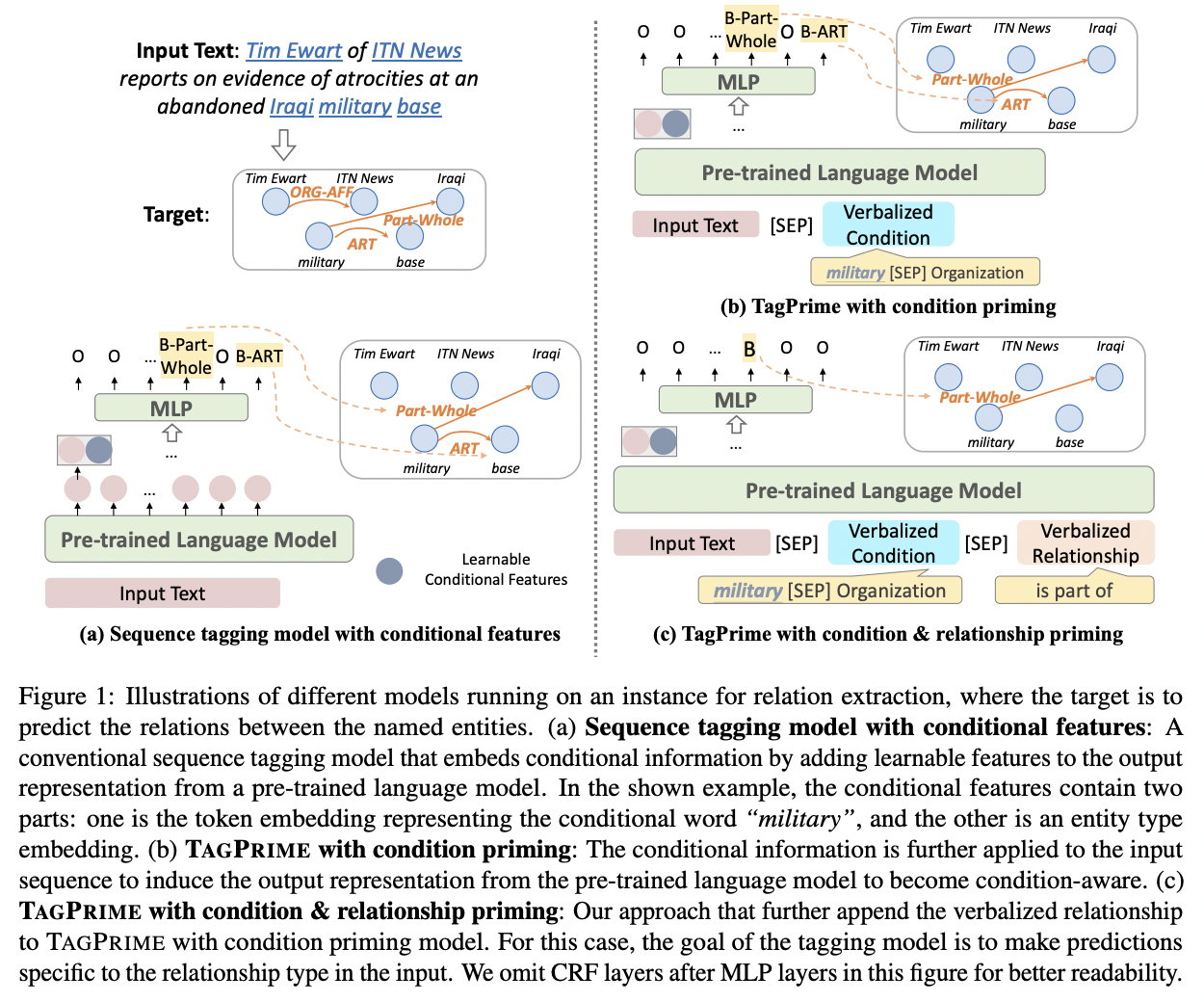
Many tasks in natural language processing require the extraction of relationship information for a given condition, such as event argument extraction, relation extraction, and task-oriented semantic parsing. Recent works usually propose sophisticated models for each task independently and pay less attention to the commonality of these tasks and to have a unified framework for all the tasks. In this work, we propose to take a unified view of all these tasks and introduce TAGPRIME to address relational structure extraction problems. TAGPRIME is a sequence tagging model that appends priming words about the information of the given condition (such as an event trigger) to the input text. With the self-attention mechanism in pre-trained language models, the priming words make the output contextualized representations contain more information about the given condition, and hence become more suitable for extracting specific relationships for the condition. Extensive experiments and analyses on three different tasks that cover ten datasets across five different languages demonstrate the generality and effectiveness of TAGPRIME.
@inproceedings{hsu2023tagprime, author = {Hsu, I-Hung and Huang, Kuan-Hao and Zhang, Shuning and Cheng, Wenxin and Natarajan, Prem and Chang, Kai-Wei and Peng, Nanyun}, title = {TAGPRIME: A Unified Framework for Relational Structure Extraction}, booktitle = {ACL}, presentation_id = {https://underline.io/events/395/sessions/15250/lecture/76330-tagprime-a-unified-framework-for-relational-structure-extraction}, year = {2023} }ParaAMR: A Large-Scale Syntactically Diverse Paraphrase Dataset by AMR Back-Translation
Kuan-Hao Huang, Varun Iyer, I.-Hung Hsu, Anoop Kumar, Kai-Wei Chang, and Aram Galstyan, in ACL, 2023.
QA Sessions: POSTER SESSION 3: July 11 09:00 AM - July 11 10:30 AM Paper link in the virtual conferenceFull Text BibTeX Details Area Chair’s AwardDetails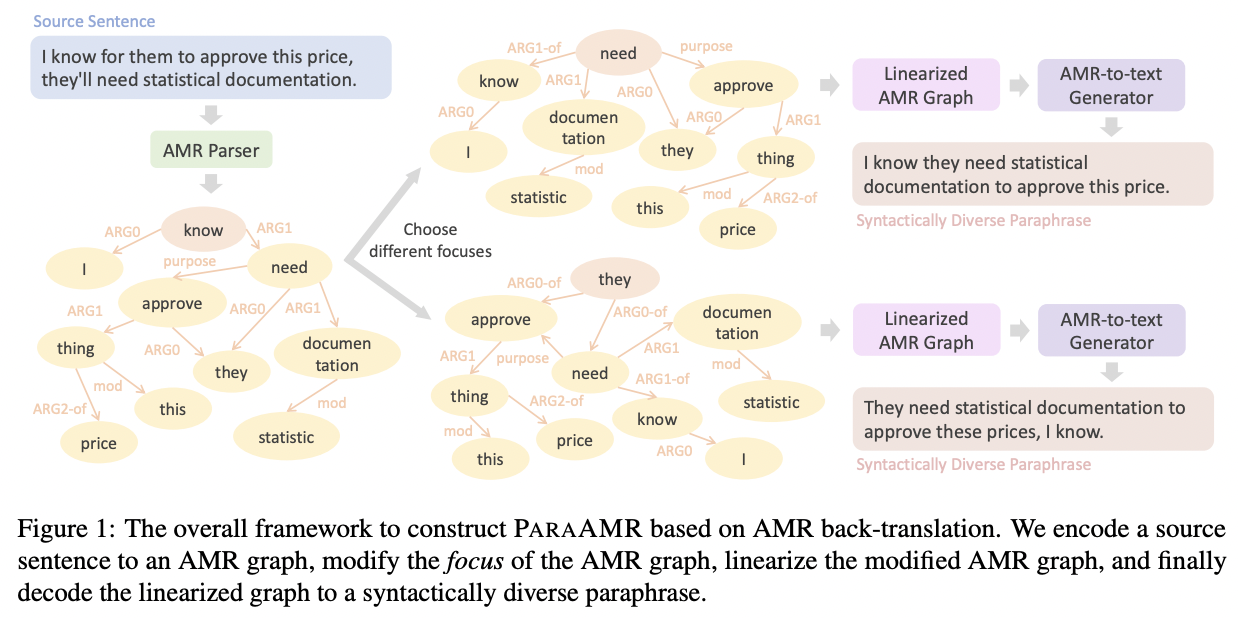
Paraphrase generation is a long-standing task in natural language processing (NLP). Supervised paraphrase generation models, which rely on human-annotated paraphrase pairs, are cost-inefficient and hard to scale up. On the other hand, automatically annotated paraphrase pairs (e.g., by machine back-translation), usually suffer from the lack of syntactic diversity – the generated paraphrase sentences are very similar to the source sentences in terms of syntax. In this work, we present ParaAMR, a large-scale syntactically diverse paraphrase dataset created by abstract meaning representation back-translation. Our quantitative analysis, qualitative examples, and human evaluation demonstrate that the paraphrases of ParaAMR are syntactically more diverse compared to existing large-scale paraphrase datasets while preserving good semantic similarity. In addition, we show that ParaAMR can be used to improve on three NLP tasks: learning sentence embeddings, syntactically controlled paraphrase generation, and data augmentation for few-shot learning. Our results thus showcase the potential of ParaAMR for improving various NLP applications.
@inproceedings{huang2023paraarm, author = {Huang, Kuan-Hao and Iyer, Varun and Hsu, I-Hung and Kumar, Anoop and Chang, Kai-Wei and Galstyan, Aram}, title = {ParaAMR: A Large-Scale Syntactically Diverse Paraphrase Dataset by AMR Back-Translation}, booktitle = {ACL}, presentation_id = {https://underline.io/events/395/posters/15227/poster/76600-paraamr-a-large-scale-syntactically-diverse-paraphrase-dataset-by-amr-back-translation}, year = {2023} }GENEVA: Pushing the Limit of Generalizability for Event Argument Extraction with 100+ Event Types
Tanmay Parekh, I.-Hung Hsu, Kuan-Hao Huang, Kai-Wei Chang, and Nanyun Peng, in ACL, 2023.
QA Sessions: POSTER SESSION 6, 7/12 9:00AM-10:30AM Paper link in the virtual conferenceFull Text Code BibTeX DetailsDetails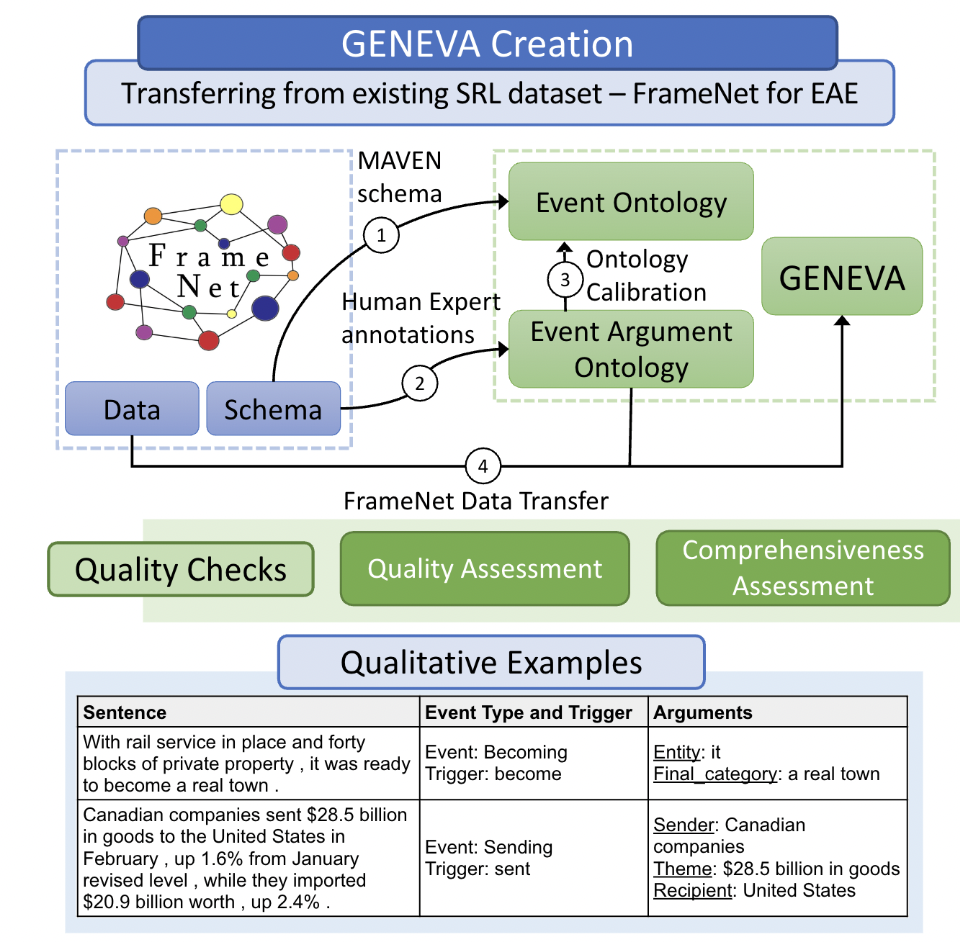
Recent works in Event Argument Extraction (EAE) have focused on improving model generalizability to cater to new events and domains. However, standard benchmarking datasets like ACE and ERE cover less than 40 event types and 25 entity-centric argument roles. Limited diversity and coverage hinder these datasets from adequately evaluating the generalizability of EAE models. In this paper, we first contribute by creating a large and diverse EAE ontology. This ontology is created by transforming FrameNet, a comprehensive semantic role labeling (SRL) dataset for EAE, by exploiting the similarity between these two tasks. Then, exhaustive human expert annotations are collected to build the ontology, concluding with 115 events and 220 argument roles, with a significant portion of roles not being entities. We utilize this ontology to further introduce GENEVA, a diverse generalizability benchmarking dataset comprising four test suites, aimed at evaluating models’ ability to handle limited data and unseen event type generalization. We benchmark six EAE models from various families. The results show that owing to non-entity argument roles, even the best-performing model can only achieve 39% F1 score, indicating how GENEVA provides new challenges for generalization in EAE. Overall, our large and diverse EAE ontology can aid in creating more comprehensive future resources, while GENEVA is a challenging benchmarking dataset encouraging further research for improving generalizability in EAE.
@inproceedings{parekh2023geneva, title = {GENEVA: Pushing the Limit of Generalizability for Event Argument Extraction with 100+ Event Types}, author = {Parekh, Tanmay and Hsu, I-Hung and Huang, Kuan-Hao and Chang, Kai-Wei and Peng, Nanyun}, booktitle = {ACL}, presentation_id = {https://underline.io/events/395/posters/15264/poster/77026-geneva-benchmarking-generalizability-for-event-argument-extraction-with-hundreds-of-event-types-and-argument-roles}, year = {2023} }Related Publications
-
GENEVA: Pushing the Limit of Generalizability for Event Argument Extraction with 100+ Event Types
Tanmay Parekh, I.-Hung Hsu, Kuan-Hao Huang, Kai-Wei Chang, and Nanyun Peng, in ACL, 2023.
Full Text Code Abstract BibTeX DetailsDetailsRecent works in Event Argument Extraction (EAE) have focused on improving model generalizability to cater to new events and domains. However, standard benchmarking datasets like ACE and ERE cover less than 40 event types and 25 entity-centric argument roles. Limited diversity and coverage hinder these datasets from adequately evaluating the generalizability of EAE models. In this paper, we first contribute by creating a large and diverse EAE ontology. This ontology is created by transforming FrameNet, a comprehensive semantic role labeling (SRL) dataset for EAE, by exploiting the similarity between these two tasks. Then, exhaustive human expert annotations are collected to build the ontology, concluding with 115 events and 220 argument roles, with a significant portion of roles not being entities. We utilize this ontology to further introduce GENEVA, a diverse generalizability benchmarking dataset comprising four test suites, aimed at evaluating models’ ability to handle limited data and unseen event type generalization. We benchmark six EAE models from various families. The results show that owing to non-entity argument roles, even the best-performing model can only achieve 39% F1 score, indicating how GENEVA provides new challenges for generalization in EAE. Overall, our large and diverse EAE ontology can aid in creating more comprehensive future resources, while GENEVA is a challenging benchmarking dataset encouraging further research for improving generalizability in EAE.
@inproceedings{parekh2023geneva, title = {GENEVA: Pushing the Limit of Generalizability for Event Argument Extraction with 100+ Event Types}, author = {Parekh, Tanmay and Hsu, I-Hung and Huang, Kuan-Hao and Chang, Kai-Wei and Peng, Nanyun}, booktitle = {ACL}, presentation_id = {https://underline.io/events/395/posters/15264/poster/77026-geneva-benchmarking-generalizability-for-event-argument-extraction-with-hundreds-of-event-types-and-argument-roles}, year = {2023} }
-
Enhancing Unsupervised Semantic Parsing with Distributed Contextual Representations
Zixuan Ling, Xiaoqing Zheng, Jianhan Xu, Jinshu Lin, Kai-Wei Chang, Cho-Jui Hsieh, and Xuanjing Huang, in ACL-Finding, 2023.
QA Sessions: VIRTUAL POSTER SESSION 3: July 12 11:00 AM - July 12 12:30 AM Paper link in the virtual conferenceBibTeX DetailsDetailsWe extend a non-parametric Bayesian model of (Titov and Klementiev, 2011) to deal with homonymy and polysemy by leveraging distributed contextual word and phrase representations pre-trained on a large collection of unlabelled texts. Then, unsupervised semantic parsing is performed by decomposing sentences into fragments, clustering the fragments to abstract away syntactic variations of the same meaning, and predicting predicate-argument relations between the fragments. To better model the statistical dependencies between predicates and their arguments, we further conduct a hierarchical Pitman-Yor process. An improved Metropolis-Hastings merge-split sampler is proposed to speed up the mixing and convergence of Markov chains by leveraging pre-trained distributed representations. The experimental results show that the models achieve better accuracy on both question-answering and relation extraction tasks.
@inproceedings{ling2023enhancing, author = {Ling, Zixuan and Zheng, Xiaoqing and Xu, Jianhan and Lin, Jinshu and Chang, Kai-Wei and Hsieh, Cho-Jui and Huang, Xuanjing}, title = {Enhancing Unsupervised Semantic Parsing with Distributed Contextual Representations}, booktitle = {ACL-Finding}, presentation_id = {https://underline.io/events/395/posters/15279/poster/77281-enhancing-unsupervised-semantic-parsing-with-distributed-contextual-representations?tab=video}, year = {2023} }PIP: Parse-Instructed Prefix for Syntactically Controlled Paraphrase Generation
Yixin Wan, Kuan-Hao Huang, and Kai-Wei Chang, in ACL-Finding (short), 2023.
QA Sessions: VIRTUAL POSTER SESSION 3: July 12 11:00 AM - July 12 12:30 AM Paper link in the virtual conferenceFull Text BibTeX DetailsDetails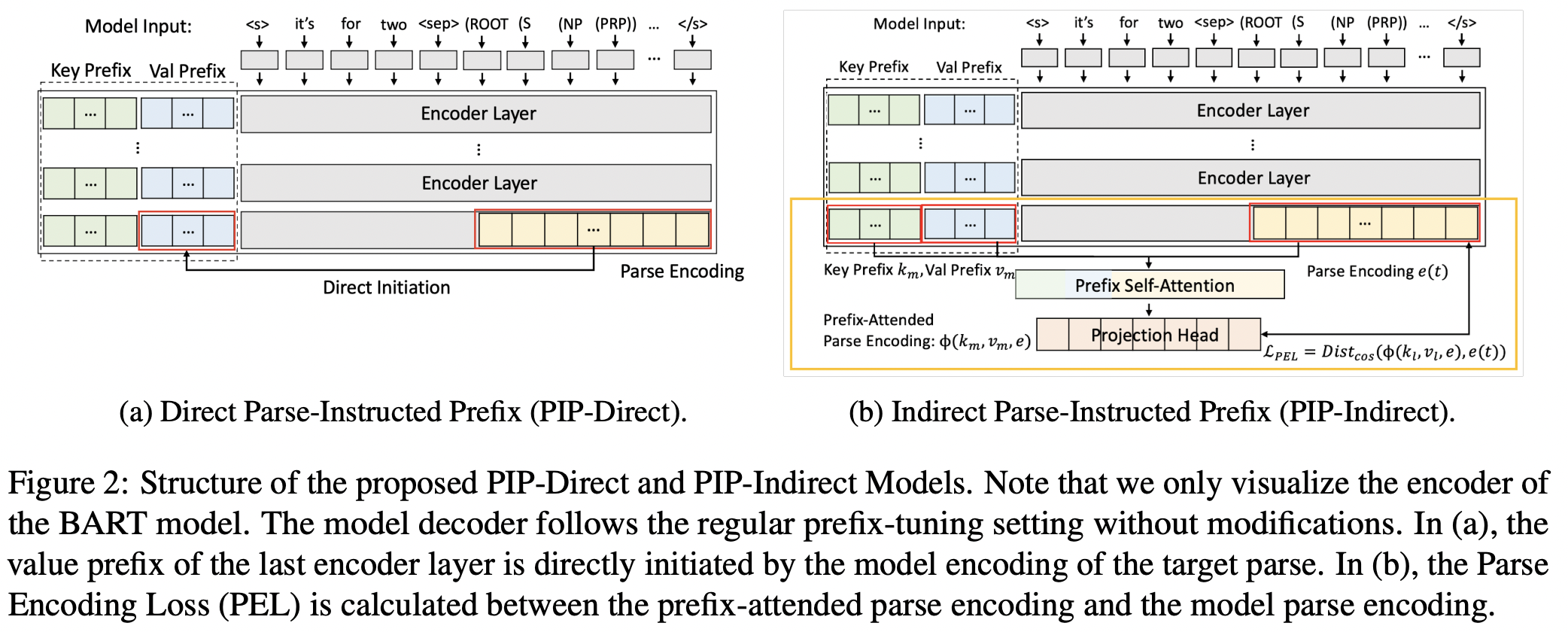
Syntactically controlled paraphrase generation requires language models to generate paraphrases for sentences according to specific syntactic structures. Existing fine-tuning methods for this task are costly as all the parameters of the model need to be updated during the training process. Inspired by recent studies on parameter-efficient learning, we propose Parse-Instructed Prefix (PIP), a novel adaptation of prefix-tuning to tune large pre-trained language models on syntactically controlled paraphrase generation task in a low-data setting with significantly less training cost. We introduce two methods to instruct a model’s encoder prefix to capture syntax-related knowledge: direct initiation (PIP-Direct) and indirect optimization (PIP-Indirect). In contrast to traditional fine-tuning methods for this task, PIP is a compute-efficient alternative with 10 times less learnable parameters. Compared to existing prefix-tuning methods, PIP excels at capturing syntax control information, achieving significantly higher performance at the same level of learnable parameter count.
@inproceedings{wan2023pip, author = {Wan, Yixin and Huang, Kuan-Hao and Chang, Kai-Wei}, title = {PIP: Parse-Instructed Prefix for Syntactically Controlled Paraphrase Generation}, booktitle = {ACL-Finding (short)}, presentation_id = {https://underline.io/events/395/posters/15279/poster/77944-pip-parse-instructed-prefix-for-syntactically-controlled-paraphrase-generation}, year = {2023} }